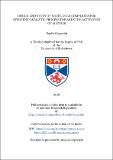Files in this item
Design and study of novel gold complexes for efficient catalytic process towards the activation of alkynes
Item metadata
| dc.contributor.advisor | Smith, Andrew David | |
| dc.contributor.author | Gasperini, Danila | |
| dc.coverage.spatial | xxii, 293 p. | en_US |
| dc.date.accessioned | 2018-06-19T11:14:55Z | |
| dc.date.available | 2018-06-19T11:14:55Z | |
| dc.date.issued | 2018-06-27 | |
| dc.identifier.uri | https://hdl.handle.net/10023/14247 | |
| dc.description.abstract | Gold has emerged as valuable tool for chemists. The physico-chemical properties of the metal centre make it exceptionally prone to activate multiple bonds, such as alkynes and alkenes. Thus, its utility in catalysis has been exploited together with the synthesis of suitable catalysts to allow new, efficient transformations, and the understanding of their intrinsic mechanisms. Reported in this thesis are efforts to this goal, such as the design and study of new Au(I) and Au(III) complexes towards functionalisation of alkynes. The development of new catalytic systems is tackled in Chapter 2. An efficient method for the intermolecular hydrocarboxylation of alkynes catalysed by dinuclear Au-NHC species to access diverse vinyl esters in excellent yield and stereoselectivity is described. The successful methodology is followed by the straightforward intramolecular hydrocarboxylation of alkynoic acids to allow the stereoselective and regioselective synthesis of γ-, δ- and ε-lactones in high yield. Initial mechanistic studies into the hydrocarboxylation of alkynes are shown in Chapter 3. The discovery and characterisation of novel dinuclear gold carboxylates species is described, and their role in the catalytic inter- and intramolecular process is investigated. Chapter 4 highlights the synthesis of novel Au complexes bearing chiral isothiourea ligands. Neutral and heteroleptic Au(I) and Au(III) species are obtained in excellent yield, and their solution and solid-state behaviour studied, together with their electronic and steric properties. Further testing towards activation and functionalisation of alkynes and propargylic derivatives are shown. Dual catalytic processes involving Au and isothiourea catalysts are presented in Chapter 5. Attempts towards Lewis acid/Lewis base activation of multiple bond derivatives and activated esters towards the formation of new C-C bonds is described. The synthesis of organogold compounds, bearing NHC ligands, is described in Chapter 6. Through deprotonation of C(sp³ )-H bonds, a series of stable gold(I) complexes was synthesised and found to be suitable synthons to different gold species. Finally, the redox chemistry of organogold species is explored. | en_US |
| dc.language.iso | en | en_US |
| dc.publisher | University of St Andrews | |
| dc.subject.lcc | QD181.A9G2 | |
| dc.subject.lcsh | Gold compounds | en |
| dc.subject.lcsh | Metal catalysts | en |
| dc.subject.lcsh | Alkynes | en |
| dc.subject.lcsh | Catalysis | en |
| dc.title | Design and study of novel gold complexes for efficient catalytic process towards the activation of alkynes | en_US |
| dc.type | Thesis | en_US |
| dc.type.qualificationlevel | Doctoral | en_US |
| dc.type.qualificationname | PhD Doctor of Philosophy | en_US |
| dc.publisher.institution | The University of St Andrews | en_US |
| dc.identifier.doi | https://doi.org/10.17630/10023-14247 |
This item appears in the following Collection(s)
Items in the St Andrews Research Repository are protected by copyright, with all rights reserved, unless otherwise indicated.

